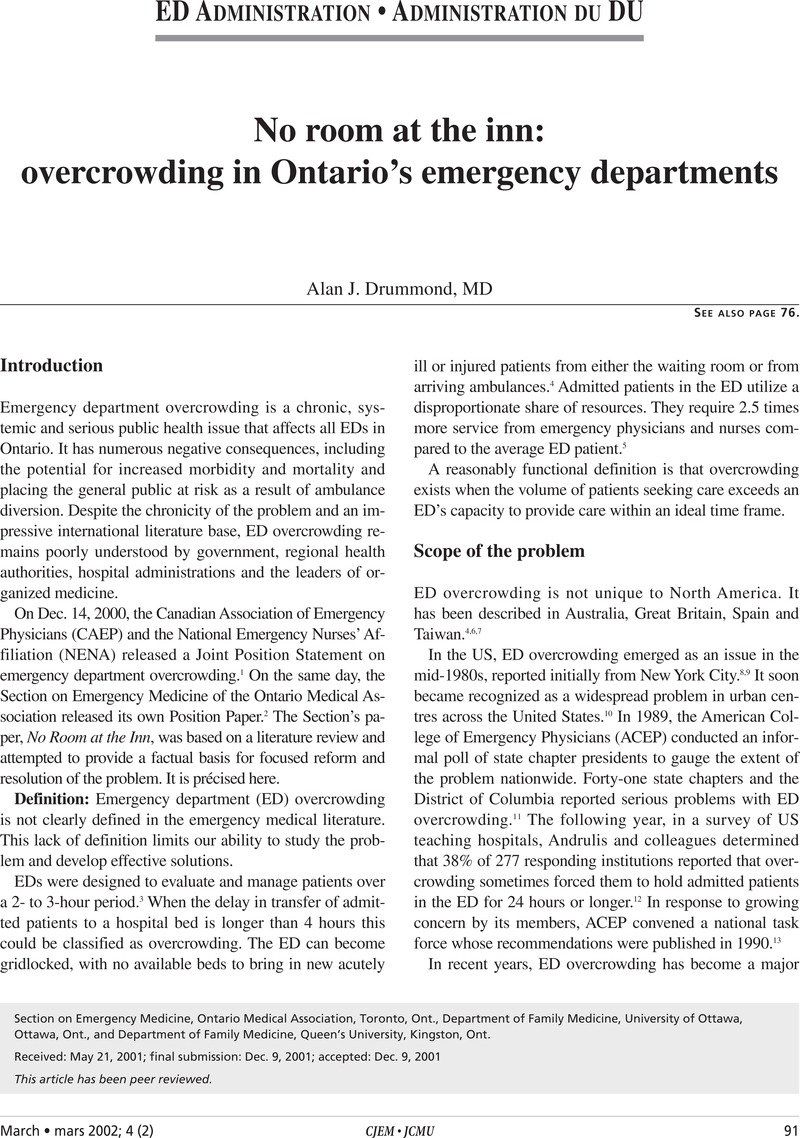Crossref Citations
This article has been cited by the following publications. This list is generated based on data provided by Crossref.
Ieraci, Sue
2002.
Ambulance diversion and ED overcrowding.
CJEM,
Vol. 4,
Issue. 04,
p.
244.
CJEN, Editorial Team
2003.
Position Statement: Access to acute care in the setting of emergency department overcrowding.
Canadian Journal of Emergency Nursing,
Vol. 26,
Issue. 1,
p.
15.
Drummond, Alan J.
and
Bingley, Michael
2003.
Nurse practitioners in the emergency department: a discussion paper.
CJEM,
Vol. 5,
Issue. 04,
p.
276.
2003.
Access to acute care in the setting of emergency department overcrowding.
CJEM,
Vol. 5,
Issue. 02,
p.
81.
Schull, Michael J.
Mamdani, Muhammad M.
and
Fang, Jiming
2004.
Community influenza outbreaks and emergency department ambulance diversion.
Annals of Emergency Medicine,
Vol. 44,
Issue. 1,
p.
61.
Noseworthy, Susan B.
2004.
Emergency department overcrowding: Waiting for disaster.
Canadian Journal of Emergency Nursing,
Vol. 27,
Issue. 1,
p.
12.
Holroyd, Brian R
Rowe, Brian H
and
Sinclair, Douglas
2004.
Current political issues facing emergency medicine in Canada.
Emergency Medicine,
Vol. 16,
Issue. 3,
p.
190.
Campbell, Samuel G.
and
Sinclair, Douglas E.
2004.
Strategies for managing a busy emergency department.
CJEM,
Vol. 6,
Issue. 04,
p.
271.
Sinclair, Douglas
2007.
Emergency department overcrowding – implications for paediatric emergency medicine.
Paediatrics & Child Health,
Vol. 12,
Issue. 6,
p.
491.
Links, Paul S.
Strike, Carol
Ball, Jeffrey S.
Bergmans, Yvonne
Rhodes, Anne E.
Spence, Julie M.
Watson, William J.
and
Rufo, Claire
2007.
The experience of suicidal, substance‐abusing men with severe personality disorders in the emergency department.
Personality and Mental Health,
Vol. 1,
Issue. 1,
p.
51.
Falvo, Thomas
Grove, Lance
Stachura, Ruth
Vega, David
Stike, Rose
Schlenker, Melissa
and
Zirkin, William
2007.
The Opportunity Loss of Boarding Admitted Patients in the Emergency Department.
Academic Emergency Medicine,
Vol. 14,
Issue. 4,
p.
332.
Szpiro, Kim A.
Harrison, Margaret B.
Van Den Kerkhof, Elizabeth G.
and
Lougheed, M. Diane
2008.
Patient Education in the Emergency Department.
Advanced Emergency Nursing Journal,
Vol. 30,
Issue. 1,
p.
34.
Lowthian, Judy A
and
Cameron, Peter A
2009.
Emergency demand access block and patient safety: A call for national leadership.
Emergency Medicine Australasia,
Vol. 21,
Issue. 6,
p.
435.
Mutrie, David
Bailey, S. Kathleen
and
Malik, Saleem
2009.
Individual emergency physician admission rates: predictably unpredictable.
CJEM,
Vol. 11,
Issue. 02,
p.
149.
Devkaran, Subashnie
Parsons, Howard
Van Dyke, Murray
Drennan, Jonathan
and
Rajah, Jaishen
2009.
The impact of a fast track area on quality and effectiveness outcomes: A Middle Eastern emergency department perspective.
BMC Emergency Medicine,
Vol. 9,
Issue. 1,
2010.
Myth: Emergency room overcrowding is caused by non-urgent cases.
Journal of Health Services Research & Policy,
Vol. 15,
Issue. 3,
p.
188.
Lizon, Natalia E.
Aleman, Dionne M.
and
Schwartz, Brian
2010.
Incorporating healthcare systems in pandemic models.
p.
2230.
Kuruvilla, Abey
Alexander, Suraj M.
and
Li, Xiaolin
2011.
A Study of the Cascading Effects of Ambulance Diversion among Hospitals.
International Journal of Information Systems in the Service Sector,
Vol. 3,
Issue. 3,
p.
60.
Qureshi, Adnan
Smith, Andy
Wright, Frances
Brenneman, Fred
Rizoli, Sandro
Hsieh, Taulee
and
Tien, Homer C.
2011.
The Impact of an Acute Care Emergency Surgical Service on Timely Surgical Decision-Making and Emergency Department Overcrowding.
Journal of the American College of Surgeons,
Vol. 213,
Issue. 2,
p.
284.
Cho, Suck Ju
Jeong, Jinwoo
Han, Sangkyoon
Yeom, Seokran
Park, Sung Wook
Kim, Hyung Hoi
and
Hwang, Seong Youn
2011.
Decreased Emergency Department Length of Stay by Application of a Computerized Consultation Management System.
Academic Emergency Medicine,
Vol. 18,
Issue. 4,
p.
398.



